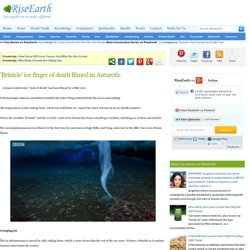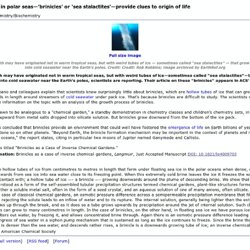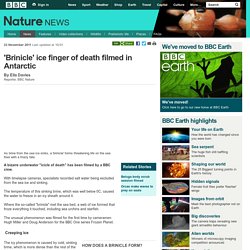

'Brinicle' ice finger of death filmed in Antarctic. A bizarre underwater "icicle of death" has been filmed by a BBC crew.

With timelapse cameras, specialists recorded salt water being excluded from the sea ice and sinking. The temperature of this sinking brine, which was well below 0C, caused the water to freeze in an icy sheath around it. Where the so-called "brinicle" met the sea bed, a web of ice formed that froze everything it touched, including sea urchins and starfish.
The unusual phenomenon was filmed for the first time by cameramen Hugh Miller and Doug Anderson for the BBC One series Frozen Planet. Creeping ice The icy phenomenon is caused by cold, sinking brine, which is more dense than the rest of the sea water. Mr Miller set up the rig of timelapse equipment to capture the growing brinicle under the ice at Little Razorback Island, near Antarctica's Ross Archipelago. The diving specialists noted the temperature and returned to the area as soon as the same conditions were repeated. HOW DOES A BRINICLE FORM? The “Brinicle” ice-finger of death freezes everything on its path in just a few seconds. Home / The “Brinicle” ice-finger of death freezes everything on its path in just a few seconds Nature can strike relentlessly, and so does water.

The “Brinicle” ice-finger of death is one of nature’s most bizarre and dangerous phenomenons, capable of freezing everything on it’s path in only a few seconds. Yes you heard it right: in only a few seconds! And now there is video footage of this ice-finger of death, filmed for the first time by the brave journalists of the spectacular BBC series “Frozen Planet”, who where able to capture this underwater tornado near the island of Little Razorback in Antarctica. But so, how does the Brinicle ice-finger develop? The icy underwater tornado comes into life when the water temperature equals -1 degrees Celcius and the temperature on land is -20 degrees Celcius. UPDATE: LINK to video on Discovery Planet Tags: antarctiva, BBC, Brinicle ice-finger of death, Frozen Planet, oceans, tornado under water.
Ice tubes in polar seas—'brinicles' or 'sea stalactites'—provide clues to origin of life. Apr 24, Chemistry/Biochemistry Life on Earth may have originated not in warm tropical seas, but with weird tubes of ice — sometimes called “sea stalactites” — that grow downward into cold seawater near the Earth's poles.

Credit: Credit: Rob Robbins; image archived by EarthRef.org Life on Earth may have originated not in warm tropical seas, but with weird tubes of ice—sometimes called "sea stalactites"—that grow downward into cold seawater near the Earth's poles, scientists are reporting. Their article on these "brinicles" appears in ACS' journal Langmuir .
Bruno Escribano and colleagues explain that scientists know surprisingly little about brinicles, which are hollow tubes of ice that can grow to several yards in length around streamers of cold seawater under pack ice. They are shown to be analogous to a "chemical garden," a standby demonstration in chemistry classes and children's chemistry sets, in which tubes grow upward from metal salts dropped into silicate solution. Ice tube 'brinicles' may conceal origins of life. Ice tube ‘brinicles’ may conceal origins of life April 24th, 2013 | Published in Arctic Ocean, Science, The Southern Ocean | 2 Comments A brinicle forms in Antarctica.

Photo: BBC Ice tubes in polar seas — ‘brinicles’ or ‘sea stalactites’ — provide clues to origin of life AMERICAN CHEMICAL SOCIETY | 24 April 2013 Life on Earth may have originated not in warm tropical seas, but with weird tubes of ice — sometimes called “sea stalactites” — that grow downward into cold seawater near the Earth’s poles, scientists are reporting.
Life on Earth may have originated not in warmtropical seas, but with weird tubes of ice —sometimes called “sea stalactites” — that growdownward into cold seawater near the Earth’spoles.Photo: Rob Robbins; image archived by EarthRef.org Bruno Escribano and colleagues explain that scientists know surprisingly little about brinicles, which are hollow tubes of ice that can grow to several yards in length around streamers of cold seawater under pack ice. Related Books: 'Brinicle' forms beneath the sea and kills everything in its path. By Daily Mail Reporter Updated: 15:29 GMT, 24 November 2011.

BBC Nature - 'Brinicle' ice finger of death filmed in Antarctic. 23 November 2011Last updated at 10:01 By Ella Davies Reporter, BBC Nature As brine from the sea ice sinks, a 'brinicle' forms threatening life on the sea floor with a frosty fate.

A bizarre underwater "icicle of death" has been filmed by a BBC crew. With timelapse cameras, specialists recorded salt water being excluded from the sea ice and sinking. The temperature of this sinking brine, which was well below 0C, caused the water to freeze in an icy sheath around it. Where the so-called "brinicle" met the sea bed, a web of ice formed that froze everything it touched, including sea urchins and starfish. The unusual phenomenon was filmed for the first time by cameramen Hugh Miller and Doug Anderson for the BBC One series Frozen Planet.